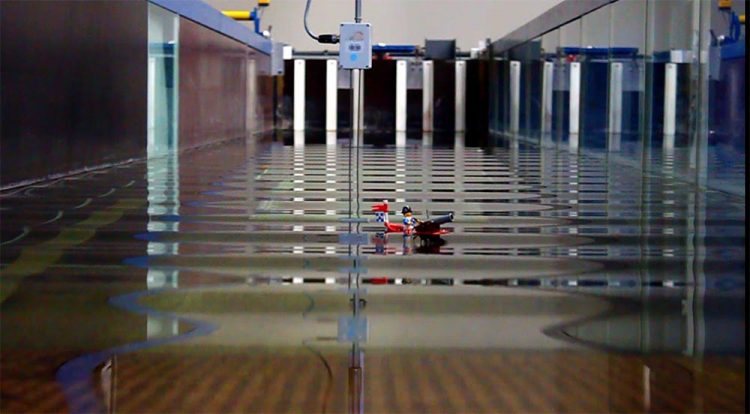Researcher creates a controlled rogue wave in realistic oceanic conditions

Potentially extremely dangerous realistic rogue waves can now be controlled and generated at will in laboratory environments. Photo: Hamburg University of Technology
The 260-meter long German barge carrier MS München was lost mysteriously at sea in 1978. The final communication message was a garbled mayday message sent from the mid-Atlantic. Afterwards, only a few bits of wreckage were found, including an unlaunched lifeboat. The most accepted theory is that one or more rogue waves hit the MS München and damaged her.
Rogue waves – also called freak waves – are unusually large surface waves that occur in the ocean. People have usually reported them as having appeared suddenly or without warning, sometimes with tremendous force. A researcher from Aalto University has now learned how they may appear in realistic oceanic conditions.
Potentially extremely dangerous realistic rogue waves can now be controlled and generated at will in laboratory environments, in similar conditions as they appear in the ocean. This will help us not only to predict oceanic extreme events, but also in the design of safer ships and offshore rigs.
In fact, newly designed vessels and rig model prototypes can be tested to encounter in a small scale, before they are built, realistic extreme ocean waves. Therefore, initial plans may change, if models are not resistant enough to face suddenly occurring freak waves, says Professor Amin Chabchoub from Aalto University.
The birth of rogue waves can be physically explained through the modulation instability of water waves. In mathematical terms, this phenomenon can be described through exact solutions of the nonlinear Schrödinger equation, also referred to as “breathers”.
For a couple of years, the research team around Professor Chabchoub has already been able to create steered rogue waves in laboratory wave flumes. However, this has only succeeded in perfect regular wave conditions. In nature, this is rarely the case.
The article has been published today in Physical Review Letters.
Media Contact
All latest news from the category: Earth Sciences
Earth Sciences (also referred to as Geosciences), which deals with basic issues surrounding our planet, plays a vital role in the area of energy and raw materials supply.
Earth Sciences comprises subjects such as geology, geography, geological informatics, paleontology, mineralogy, petrography, crystallography, geophysics, geodesy, glaciology, cartography, photogrammetry, meteorology and seismology, early-warning systems, earthquake research and polar research.
Newest articles

Bringing bio-inspired robots to life
Nebraska researcher Eric Markvicka gets NSF CAREER Award to pursue manufacture of novel materials for soft robotics and stretchable electronics. Engineers are increasingly eager to develop robots that mimic the…

Bella moths use poison to attract mates
Scientists are closer to finding out how. Pyrrolizidine alkaloids are as bitter and toxic as they are hard to pronounce. They’re produced by several different types of plants and are…

AI tool creates ‘synthetic’ images of cells
…for enhanced microscopy analysis. Observing individual cells through microscopes can reveal a range of important cell biological phenomena that frequently play a role in human diseases, but the process of…





















